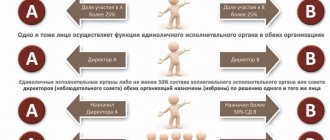We recently held a webinar on Clerk where we talked about tax risks for companies. We have collected the most important things in our checklist today. He will help you analyze the state of your business, identify tax risks, and tell you how to eliminate them.
The checklist contains the following information:
- key tax risks regarding corporate income tax and VAT;
- methods for independently identifying such risks;
- options for their elimination or minimization.
Risk No. 1. Cooperation with unscrupulous counterparties
What will be the consequences of failure to eliminate
Denial of income tax expenses and VAT deductions.
How to identify risk
- Select counterparties with contracts for significant amounts.
- Exclude well-known companies in your industry from the list of selected counterparties.
- For the remaining counterparties, analyze information from open sources for the presence of risk criteria.
Eliminating risk
After identifying high-risk counterparties, ensure that you have a set of documents confirming that you exercised due diligence and commercial diligence before entering into an agreement with each counterparty.
Analyze these documents for errors, inconsistencies, as well as changes in requirements for the counterparty, taking into account the duration of the cooperation period. If negative factors are identified, it is necessary to bring the documents into proper form.
If such documents are missing, send a lawyer’s request to the counterparty to provide documents and information confirming the availability of labor and material resources to fulfill contractual obligations.
In addition, check whether all funds have been paid to counterparties under existing agreements.
If settlements under the agreement are not completed, consider suspending the payment of funds under agreements with the specified counterparties in order to initiate pre-trial, and in some cases, judicial settlement of the dispute.
At this stage, it is necessary to collect security files that allow you to record the reality of the dispute and, consequently, the relationship with the counterparty:
- notarize correspondence with officials of the counterparty in instant messengers and email;
- save claims, reconciliation reports, responses to claims, receipts, checks for sending postal items;
- document meetings of the parties with appropriate protocols, as well as record them using audio and video means;
- conduct legal interviews with officials, etc.
In the event of a trial, the documents available in the case materials, as well as the fact of the dispute itself, will additionally confirm the commercial independence and independence of the parties.
If there is no debt to the disputed counterparty, it is necessary to analyze the relationship and the results of the contract and, if possible, initiate a legal dispute with the counterparty.
Current evaluation criteria
For the analysis, the Federal Tax Service has developed a special list of criteria by which the degree of fiscal losses is determined. Please note that this list is not secret. That is, tax authorities strongly recommend conducting independent audits according to this list. This approach will allow the company to avoid fiscal violations and penalties.
So, the current criteria for assessing tax risks are enshrined in the Order of the Federal Tax Service of Russia dated May 30, 2007 No. MM-3-06 / [email protected] and reflect:
| Absence |
|
| Availability |
|
These criteria apply not only to taxpayers on OSNO, but also to “simplified” taxpayers who have switched to special tax regimes. For example, the tax risks of the business of legal entities and individual entrepreneurs will be assessed using the simplified tax system or UTII.
Let us note that based on the analysis of these criteria, the external and internal tax policies of our country are formed, and the tax risks of the state as a whole are assessed. This approach allows for timely adjustments to current policies in order to avoid adverse consequences.
Risk No. 2. Business splitting is declared illegal
Liability for failure to eliminate
Recalculation of tax liabilities using the general taxation system.
We identify signs of fragmentation
If your business contains several legal entities, check your structure for the presence of legal entities and individual entrepreneurs that apply special tax regimes (STS, patent, Unified Agricultural Tax) or use tax preferences (regional preferential tax rates, benefits of special economic zones, benefits for IT- companies).
If there are such organizations or individual entrepreneurs in the group, the following circumstances will indicate potential risks
- the presence of a unified management apparatus;
- general accounting, warehouse, office space or retail space;
- companies or individual entrepreneurs have the same phone numbers and addresses;
- the right to sign in bank documents of one organization of a group of companies is granted to employees registered in other organizations of the group of companies;
- an identical IP address for all companies or individual entrepreneurs, generated when accessing the Bank-Client system, as well as submitting financial and tax reporting;
Signs of crushing can also be seen if:
- employees undergo interviews in the office of one company;
- there is a transfer (re-registration) of employees from one company to another;
- advertisements for hiring employees of all companies or individual entrepreneurs are prepared and posted by the HR department of one company;
- the activities of all companies or individual entrepreneurs are built into a single production/trading cycle.
- all companies or individual entrepreneurs use one website, registered under one legal entity, on which its contact information is posted in the absence of information about other group members.
How to eliminate or minimize the risk
- Eliminate or minimize identified factors that indicate artificial fragmentation of the business.
- Prepare an economic justification for the splitting carried out, based on the official positions of the Federal Tax Service and the Ministry of Finance, as well as conclusions arising from current judicial practice.
- Collect documentary defense files that support the position you have formed. For example, a model that provides conditions for registering new group members, a business development strategy when entering new markets (regions), etc.
- Consider structuring a group of companies or individual entrepreneurs using a franchise (commercial concession agreement).
Business fragmentation
The Federal Tax Service also pays considerable attention to schemes related to business division. This is recognized as the artificial division of an organization into several small entities in order to reduce the payment of taxes. Article 54.1 of the Tax Code of the Russian Federation states that any operation of an economic entity must have a business purpose . Tax evasion cannot be such a goal. And if there is no obvious sense in dividing the organization, and the tax benefit as a result of this is obvious, then there is every reason to suspect artificial fragmentation.
Of course, the creation of additional structures does not always mean fragmentation in order to reduce taxes. Let's compare the situations:
- Two organizations with the same founders, addresses, activities of the director and other personnel. Documents are signed by the same people, reports are sent from the same computer, and a common advertising campaign is conducted. Obviously, the division of the organization takes place only on paper .
- Two organizations that also have basically the same things, but there is a nuance. The director works in the second company part-time (in his free time from performing his main functions). The types of activities of these legal entities differ - one is engaged in production, the other provides transport services. It is quite logical that a special legal entity with the appropriate name is created for a separate direction. For example, it would be appropriate to include “transport company” in the name of the second company - this will be a plus from a marketing point of view. The division has a specific business purpose . Judicial practice confirms the legitimacy of this approach.
What will happen if the tax authorities see fragmentation? For example, if these are two “simplified” organizations, they will be considered as a single whole , their revenue will add up, and if the simplified tax system limit is exceeded, the structure will be transferred to the main tax regime.
Risk No. 3. Reclassification of relationships with self-employed and individual entrepreneurs into labor ones
Failure to eliminate this risk will result in additional personal income tax and insurance premiums.
We identify the risk of contract requalification
If you cooperate with self-employed people and individual entrepreneurs, factors indicating the presence of a risk of reclassifying the relationship as an employment relationship will be:
- work or services are performed in collective labor conditions, subject to internal labor regulations and compliance with labor discipline;
- fixed payment for the labor process, and not for the final result;
- regular and equal amounts of payments;
- duration of relationships with self-employed and individual entrepreneurs;
- the search for performers is carried out by posting job advertisements ;
- the presence of facts confirming that performers passed interviews in the human resources department instead of communicating through the procurement department or legal department;
- their previous performance of duties under an employment contract in your organization;
- availability of equipped workplaces on the customer’s premises;
- self-employed and individual entrepreneurs perform work (provide services) exclusively to your organization in the absence of other customers.
We eliminate risks under controversial contracts with self-employed people
The main thing is to end relationships with performers who previously worked in your organization or individual entrepreneur.
To attract new performers (self-employed or individual entrepreneurs), you need to use special online services, not job boards.
Additionally, you can make sure that the performers have other clients besides your organization, and also document this fact.
If the performers do not have other clients, it is necessary to motivate them to do business with other clients. Otherwise, it is advisable to consider the possibility of refusing to continue relations with such performers.
Analyze contractual relationships with performers and eliminate signs that may indicate a risk of reclassifying the relationship as an employment relationship.
If performers have jobs, you must refuse to organize them on the territory of your organization.
Watch the webinar recording: “Tax risks in 2022 and methods for minimizing them.”
Risk No. 4. Risks of attracting third-party employees (outstaffing)
What will be the consequences of failure to eliminate
Refusal to accept VAT deductions for transactions with companies providing personnel for rent (hereinafter referred to as outstaffers).
We determine the presence of risks in the company
If third-party employees are hired, the following circumstances may indicate the presence of risks:
- lack of information on the Rostrud website about whether the outstaffing company has accreditation as a private employment agency and the corresponding license;
- the outstaffer is an affiliate of you ;
- the outstaff company was registered shortly before the conclusion of the transaction to provide employees;
- your organization is the only customer for the outstaffing organization;
- Employee interviews are carried out by specialists from the HR department of your organization;
- recruitment advertisements are prepared and posted by the HR department of your organization;
- recruitment advertisements contain telephone numbers and other contact details of your company ;
- employees previously worked in your company, but were provided by other outstaffers.
We eliminate risks if they exist
First, you need to delete advertisements for hiring employees if they exist. Then - cancel the process of your organization’s specialists conducting interviews of accepted employees.
Be sure to: terminate relationships with employees who previously worked in your organization, as well as those previously provided by other outstaffers.
You can also collect information about the existence of labor disputes between employees and outstaffers, which will confirm the reality of their relationship .
Additionally worth:
- stop making payments for employees who are not actually working, for example, on vacation (if any);
- initiate labor disputes with outstaffers, in which it is possible to document the relationship between outstaffers and employees.
Tax risk criteria
For all individual entrepreneurs and LLCs
- Low tax burden. It is calculated using a simple formula: the amount of taxes paid is divided by revenue and multiplied by 100%.
The obtained result is compared with the average for a specific industry. This data can be found in the public domain on the tax website. If the result is noticeably lower than the industry average, then you are one step closer to a tax audit. For example, you have a small hotel. During the year, we earned 1,200,000 rubles and paid 140,000 in taxes. Tax burden = (140000/1200000)*100% = 11.6%. This is higher than the average tax burden for the hotel business: it is 9.5%. So there is nothing to worry about. - Ignoring requests from tax authorities. If, during a desk audit, the tax office identifies errors in reporting or finds contradictions in the submitted documents, it sends a request to the company. According to the regulations, a response or explanation is sent to the supervisory authority within 5 working days. If a company doesn't respond, it may no longer exist. To find out if this is so, the tax office initiates an on-site audit.
- Repeated “movement” of the taxpayer between tax authorities. This applies to companies that change their location twice during a calendar year. Tax authorities interpret a change of address as a desire to avoid audits.
- Employee salaries are below the industry average in your region. Industry average data can be viewed on the Rosstat website. Why is this factor so important? It may mean that the company pays part of the salary in an envelope, therefore saving on taxes and contributions for employees.
- Repeatedly approaching the indicators of companies operating under special regimes to their maximum values. This criterion is valid for companies and individual entrepreneurs in special regimes: simplified tax system, UTII and unified agricultural tax.
If a company approaches the limit values by less than 5% at least a couple of times during the year, this is a reason for the tax authorities to take a closer look at the company’s activities. The limit values for the special regimes of the simplified tax system and UTII are specified in Art. 346.12, 346.13 and 346.26 of the Tax Code of the Russian Federation. We cited them in articles about the simplified tax system and UTII. For example, a company pays the Unified Agricultural Tax tax. It must receive at least 70% of its income from agricultural activities. Throughout the year, her income remains at 70-75%. The tax office suspects that the company has already lost the right to apply the regime and is understating its income from other activities. The inspector checks it according to other criteria and discovers that the employees’ salaries are below the industry average, or rather, all of them according to the minimum wage. He calculates possible additional charges and provides a verification plan to the manager. There is a knock on the door at the entrepreneur's office.
For the simplified tax system “Income minus expenses” and OSNO
- Reflection of losses in financial statements over several tax periods. The critical indicator is two or more calendar years. The supervisory authority may get the impression that this is being done artificially in order to avoid paying taxes.
- The growth rate of expenses exceeds that of income. What’s criminal about this, the entrepreneur asks? And there are plenty of reasons for suspicion: after all, there are ways to deliberately inflate expenses or reduce income. And all this with the goal of paying less taxes. If your expenses are growing, be prepared for the tax office to send a letter demanding clarification.
- The amounts of expenses are almost equal to the amounts of income received during the calendar year. This point applies to individual entrepreneurs. It is a signal that if the amount of expenses is as close as possible to the amount of income, tax authorities have every reason to believe that the entrepreneur is adjusting the amount to reduce the amount of tax.
For VAT payers
- Reflection in reporting of significant amounts of tax deductions for VAT. According to this criterion, companies operating on the common taxation system (OSNO) are checked. Why is it so important? Sometimes entrepreneurs abuse fictitious transactions with suppliers of goods and services in order to increase the size of the deduction. An alarming figure is 89% or more; the tax office has every reason to start an audit.
- Building activities through concluding agreements with a chain of counterparties without reasonable economic or other reasons. In other words, a company that operates in a chain of interconnected suppliers and buyers and spends fairly large sums of money has all the signs of a fly-by-night company. They are listed in more detail in the Resolution of the Plenum of the Supreme Arbitration Court of Russia dated October 12, 2006 No. 53.
- Conducting activities with high tax risks. The tax authority divides payers into three categories: low, medium and high risks.
High risk means that the company is similar to a fly-by-night company: perhaps it is involved in schemes to reduce VAT. The tax authorities provide the criteria on the website, in paragraph 12 of Appendix No. 2. Among them, for example, a lack of information about the company and the manager’s refusal to communicate. Dealing with problematic counterparties is also bad. The tax office will suspect that you are participating in the schemes. Therefore, check the company before making a deal.
Only for OSNO
- Low level of profitability. Relevant for companies on OSNO. For control, indicators of return on sales and assets for the industry are taken. If they are 10 percent or more lower, the tax office suspects a deliberate understatement of income. The calculation of profitability for different types of OKVED is specified in Appendix No. 4 to the Order of the Federal Tax Service of Russia dated May 30, 2007 N MM-3-06/ [email protected]







